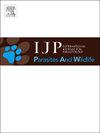欧亚大陆哪里有驼鹿(Alces Alces),哪里就有驼鹿鼻蝇:在哈萨克斯坦首次发现乌氏鼻蝇(Brauer, 1862)的形态和分子鉴定
IF 2.2
3区 医学
Q3 ECOLOGY
International Journal for Parasitology-Parasites and Wildlife
Pub Date : 2025-05-20
DOI:10.1016/j.ijppaw.2025.101086
引用次数: 0
摘要
近年来,哈萨克斯坦的欧亚驼鹿(Alces Alces)数量显著增加。根据2024年的估计,目前约有8960人,主要分布在该国北部和东部地区。然而,关于哈萨克斯坦驼鹿寄生虫的信息有限。在2023年7月和2024年5月在Akmola和Kostanay省捕获的7只驼鹿中,有4只在鼻咽部发现了8-12只双翅蝇幼虫。经形态学鉴定,该幼虫为乌氏赤霉(赤霉科:赤霉科)三龄幼虫。通过聚合酶链反应扩增和线粒体细胞色素氧化酶亚基I基因的部分测序,对该幼虫进行了分子鉴定,结果表明,该幼虫与瑞典乌氏弓形虫参考分离物的同源性为99%。哈萨克分离株的基因序列与参考样本聚集在一个进化枝上,与其他头孢菌属不同。这是哈萨克斯坦驼鹿中首次报告乌氏弓形虫鼻咽蝇病,标志着中亚地区首次此类报告,并扩大了该寄生虫已知的地理范围。本文章由计算机程序翻译,如有差异,请以英文原文为准。

Where there are moose (Alces alces) in Eurasia, there are moose nose botflies: First morphological and molecular identification of Cephenemyia ulrichii (Brauer, 1862) in Kazakhstan
In recent years, the Eurasian moose (Alces alces) population in Kazakhstan has increased significantly. According to 2024 estimates, there are now approximately 8960 individuals, primarily in the northern and eastern regions of the country. However, there is limited information on moose parasites in Kazakhstan. Four of seven moose hunted in the Akmola and Kostanay provinces in July 2023 and May 2024 were found to be infested with 8–12 dipterous fly larvae in the nasopharynx. The larvae were morphologically identified as Cephenemyia ulrichii (Oestridae: Oestrinae) third-instar larvae. Molecular characterization through polymerase chain reaction amplification and partial sequencing of the mitochondrial cytochrome oxidase subunit I gene from the larvae showed that it was 99 % identical to a reference C. ulrichii isolate from Sweden. The gene sequences of the Kazakh isolates clustered in a clade with the reference sample, distinct from other Cephenemyia species. This is the first report of C. ulrichii nasopharyngeal myiasis in moose in Kazakhstan, marking the first such report in Central Asia and expanding the known geographical range of this parasite.
求助全文
通过发布文献求助,成功后即可免费获取论文全文。
去求助
来源期刊

International Journal for Parasitology-Parasites and Wildlife
Medicine-Infectious Diseases
CiteScore
3.80
自引率
5.60%
发文量
113
审稿时长
45 days
期刊介绍:
The International Journal for Parasitology: Parasites and Wildlife (IJP-PAW) publishes the results of original research on parasites of all wildlife, invertebrate and vertebrate. This includes free-ranging, wild populations, as well as captive wildlife, semi-domesticated species (e.g. reindeer) and farmed populations of recently domesticated or wild-captured species (e.g. cultured fishes). Articles on all aspects of wildlife parasitology are welcomed including taxonomy, biodiversity and distribution, ecology and epidemiology, population biology and host-parasite relationships. The impact of parasites on the health and conservation of wildlife is seen as an important area covered by the journal especially the potential role of environmental factors, for example climate. Also important to the journal is ''one health'' and the nature of interactions between wildlife, people and domestic animals, including disease emergence and zoonoses.
 求助内容:
求助内容: 应助结果提醒方式:
应助结果提醒方式:


